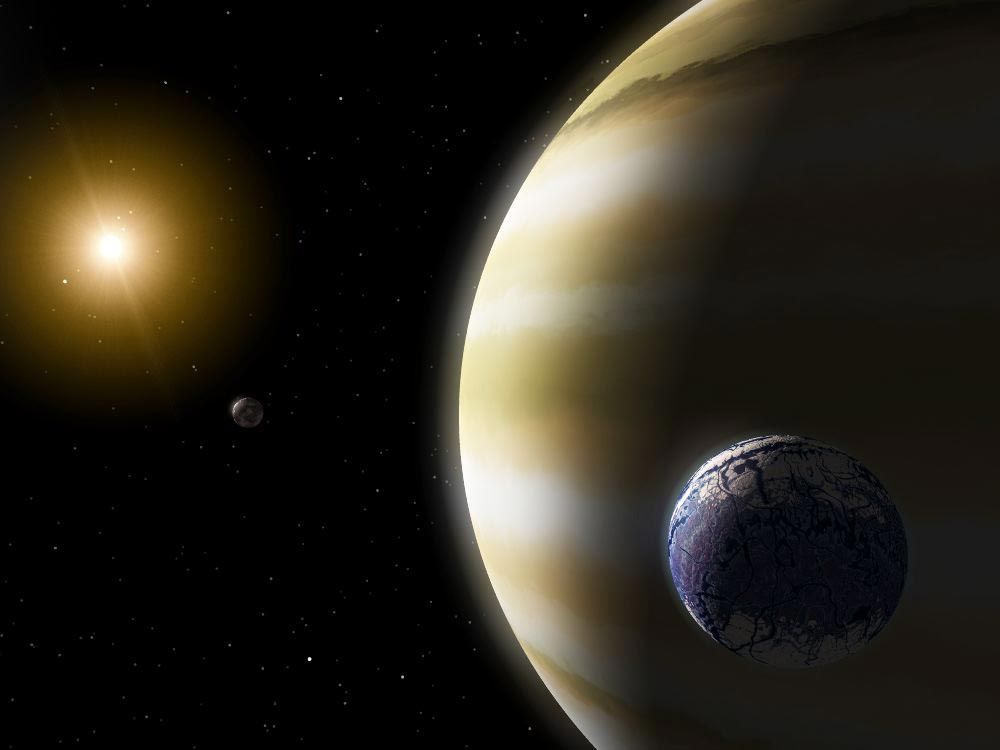
Scientists have identified a staggering 3,700 planets orbiting distant stars, and they know that there's a very good chance many of those planets have moons, just like Earth and most of our neighbors do. And according to a recent paper, the first publicized possible moon sighting—if confirmed—would almost certainly shred our current best theories about how moons form.
Last summer, a team of astronomers realized they may have managed to spot the very first alien moon, orbiting a planet called Kepler-1625 b. But they announced the possibility in order to quash rumors circulating on Twitter; they wanted to be transparent about just how shaky their data still were. Even in their paper's abstract, they insisted their finding, "should be treated as no more than a hint at this time." When they wrote that, they were waiting to use the Hubble Space Telescope to take more detailed observations of the celestial smudge.
Since then, scientists have managed to spot the planet three separate times. Such sightings were how the original astronomers hatched their theory the planet had a moon: the tiny dips in brightness caused by the planet blocking its sun's light looked a little funny. It was lopsided, as if the planet had an impossible bulge—or a moon.
Of course, the theory is totally plausible. Our solar system has more than 150 moons, and there's no reason to suspect other solar systems would lack them. But even in our own solar system, moons can be tricky to spot: Scientists identified two new ones around Jupiter in 2017. Adding a bunch of light years of distance makes the feat even harder.
In the new paper—by René Heller an astrophysicist at the Max Planck Institute for Solar System Research in Germany and colleagues and published to the pre-print server arxiv.org—the original scientist re-analyzed the same data and found the numbers don't make sense. Astronomers don't know how large Kepler-1625 b is; the new paper estimates it could be anywhere from a little larger than Saturn to more than 100 times the mass of Jupiter, which would make it a very small star. The possible moon, named Kepler 1625 b-i, would be between the sizes of Earth and of Neptune.
There's just one tiny problem: That size doesn't make sense with anything scientists know about how moons form. There are three possible paths to becoming a moon: a giant collision could spew matter into space, where it clumps together (as happened with our own moon); smaller piece of dust and rock can stick together; or, very occasionally, the gravitational pull of planets can trap hunks of rock in orbit.
Based on what scientists know so far about the (still theoretical) Kepler 1625 b-i, it would have to be much larger than any moon in our own solar system—so large that it's highly unlikely either of the first two scenarios could be responsible.
"The bottom line is that Kepler 1625 b-i is one of the best exomoon candidates so far," Heller told Space.com, "but it's still not a good candidate."
Uncommon Knowledge
Newsweek is committed to challenging conventional wisdom and finding connections in the search for common ground.
Newsweek is committed to challenging conventional wisdom and finding connections in the search for common ground.
About the writer
Meghan Bartels is a science journalist based in New York City who covers the science happening on the surface of ... Read more
To read how Newsweek uses AI as a newsroom tool, Click here.








